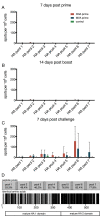A modified vaccinia Ankara vaccine vector expressing a mosaic H5 hemagglutinin reduces viral shedding in rhesus macaques
- PMID: 28771513
- PMCID: PMC5542451
- DOI: 10.1371/journal.pone.0181738
A modified vaccinia Ankara vaccine vector expressing a mosaic H5 hemagglutinin reduces viral shedding in rhesus macaques
Abstract
The rapid antigenic evolution of influenza viruses requires frequent vaccine reformulations. Due to the economic burden of continuous vaccine reformulation and the threat of new pandemics, there is intense interest in developing vaccines capable of eliciting broadly cross-reactive immunity to influenza viruses. We recently constructed a "mosaic" hemagglutinin (HA) based on subtype 5 HA (H5) and designed to stimulate cellular and humoral immunity to multiple influenza virus subtypes. Modified vaccinia Ankara (MVA) expressing this H5 mosaic (MVA-H5M) protected mice against multiple homosubtypic H5N1 strains and a heterosubtypic H1N1 virus. To assess its potential as a human vaccine we evaluated the ability of MVA-H5M to provide heterosubtypic immunity to influenza viruses in a non-human primate model. Rhesus macaques received an initial dose of either MVA-H5M or plasmid DNA encoding H5M, followed by a boost of MVA-H5M, and then were challenged, together with naïve controls, with the heterosubtypic virus A/California/04/2009 (H1N1pdm). Macaques receiving either vaccine regimen cleared H1N1pdm challenge faster than naïve controls. Vaccination with H5M elicited antibodies that bound H1N1pdm HA, but did not neutralize the H1N1pdm challenge virus. Plasma from vaccinated macaques activated NK cells in the presence of H1N1pdm HA, suggesting that vaccination elicited cross-reactive antibodies capable of mediating antibody-dependent cell-mediated cytotoxicity (ADCC). Although HA-specific T cell responses to the MVA-H5M vaccine were weak, responses after challenge were stronger in vaccinated macaques than in control animals. Together these data suggest that mosaic HA antigens may provide a means for inducing broadly cross-reactive immunity to influenza viruses.
Conflict of interest statement
Figures





Similar articles
-
Modified vaccinia virus Ankara encoding influenza virus hemagglutinin induces heterosubtypic immunity in macaques.J Virol. 2014 Nov;88(22):13418-28. doi: 10.1128/JVI.01219-14. Epub 2014 Sep 10. J Virol. 2014. PMID: 25210172 Free PMC article.
-
Mosaic H5 Hemagglutinin Provides Broad Humoral and Cellular Immune Responses against Influenza Viruses.J Virol. 2016 Jul 11;90(15):6771-6783. doi: 10.1128/JVI.00730-16. Print 2016 Aug 1. J Virol. 2016. PMID: 27194759 Free PMC article.
-
Broad protection against avian influenza virus by using a modified vaccinia Ankara virus expressing a mosaic hemagglutinin gene.J Virol. 2014 Nov;88(22):13300-9. doi: 10.1128/JVI.01532-14. Epub 2014 Sep 10. J Virol. 2014. PMID: 25210173 Free PMC article.
-
ADCC: An underappreciated correlate of cross-protection against influenza?Front Immunol. 2023 Feb 22;14:1130725. doi: 10.3389/fimmu.2023.1130725. eCollection 2023. Front Immunol. 2023. PMID: 36911705 Free PMC article. Review.
-
Modified vaccinia virus ankara (MVA) as production platform for vaccines against influenza and other viral respiratory diseases.Viruses. 2014 Jul 17;6(7):2735-61. doi: 10.3390/v6072735. Viruses. 2014. PMID: 25036462 Free PMC article. Review.
Cited by
-
Targeting Antigens for Universal Influenza Vaccine Development.Viruses. 2021 May 24;13(6):973. doi: 10.3390/v13060973. Viruses. 2021. PMID: 34073996 Free PMC article. Review.
-
Strategies Targeting Hemagglutinin as a Universal Influenza Vaccine.Vaccines (Basel). 2021 Mar 13;9(3):257. doi: 10.3390/vaccines9030257. Vaccines (Basel). 2021. PMID: 33805749 Free PMC article. Review.
-
Influenza and Antibody-Dependent Cellular Cytotoxicity.Front Immunol. 2019 Jun 25;10:1457. doi: 10.3389/fimmu.2019.01457. eCollection 2019. Front Immunol. 2019. PMID: 31316510 Free PMC article. Review.
-
The Next Generation of Influenza Vaccines: Towards a Universal Solution.Vaccines (Basel). 2021 Jan 7;9(1):26. doi: 10.3390/vaccines9010026. Vaccines (Basel). 2021. PMID: 33430278 Free PMC article. Review.
-
Antibody-dependent cell-mediated cytotoxicity antibody responses to inactivated and live-attenuated influenza vaccination in children during 2014-15.Vaccine. 2020 Feb 18;38(8):2088-2094. doi: 10.1016/j.vaccine.2019.10.060. Epub 2019 Nov 18. Vaccine. 2020. PMID: 31753674 Free PMC article. Clinical Trial.
References
-
- WHO (2014) Influenza (Seasonal) Fact Sheet N211. Available: http://www.who.int/mediacentre/factsheets/fs211/en/ via the Internet. Accessed x.
-
- Air GM, Laver WG, Webster RG (1987) Antigenic variation in influenza viruses. Contrib Microbiol Immunol 8: 20–59. - PubMed
MeSH terms
Substances
Grants and funding
LinkOut - more resources
Full Text Sources
Other Literature Sources

